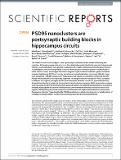Files in this item
PSD95 nanoclusters are postsynaptic building blocks in hippocampus circuits
Item metadata
| dc.contributor.author | Broadhead, Matthew James | |
| dc.contributor.author | Horrocks, Mathew | |
| dc.contributor.author | Zhu, Fei | |
| dc.contributor.author | Muresan, Leila | |
| dc.contributor.author | Benavides-Piccione, Ruth | |
| dc.contributor.author | DeFelipe, Javier | |
| dc.contributor.author | Fricker, David | |
| dc.contributor.author | Kopanitsa, Maksym V. | |
| dc.contributor.author | Duncan, Rory R. | |
| dc.contributor.author | Klenerman, David | |
| dc.contributor.author | Komiyama, Noboru H. | |
| dc.contributor.author | Lee, Steven F. | |
| dc.contributor.author | Grant, Seth G. N. | |
| dc.date.accessioned | 2020-06-25T15:30:02Z | |
| dc.date.available | 2020-06-25T15:30:02Z | |
| dc.date.issued | 2016-04-25 | |
| dc.identifier | 268444417 | |
| dc.identifier | eb4d0f25-837a-425a-aadf-e2a34375cbf2 | |
| dc.identifier | 84964619961 | |
| dc.identifier.citation | Broadhead , M J , Horrocks , M , Zhu , F , Muresan , L , Benavides-Piccione , R , DeFelipe , J , Fricker , D , Kopanitsa , M V , Duncan , R R , Klenerman , D , Komiyama , N H , Lee , S F & Grant , S G N 2016 , ' PSD95 nanoclusters are postsynaptic building blocks in hippocampus circuits ' , Scientific Reports , vol. 6 , 24626 . https://doi.org/10.1038/srep24626 | en |
| dc.identifier.issn | 2045-2322 | |
| dc.identifier.uri | https://hdl.handle.net/10023/20150 | |
| dc.description | Support from the Wellcome Trust, Medical Research Council, European Union Seventh Framework Programme (FP7/2007-2013) under grant agreements no. 604102 (HBP), 241995 (GENCODYS), 242498 (EUROSPIN), 242167 (SYNSYS). | en |
| dc.description.abstract | The molecular features of synapses in the hippocampus underpin current models of learning and cognition. Although synapse ultra-structural diversity has been described in the canonical hippocampal circuitry, our knowledge of sub-synaptic organisation of synaptic molecules remains largely unknown. To address this, mice were engineered to express Post Synaptic Density 95 protein (PSD95) fused to either eGFP or mEos2 and imaged with two orthogonal super-resolution methods: gated stimulated emission depletion (g-STED) microscopy and photoactivated localisation microscopy (PALM). Large-scale analysis of ~100,000 synapses in 7 hippocampal sub-regions revealed they comprised discrete PSD95 nanoclusters that were spatially organised into single and multi-nanocluster PSDs. Synapses in different sub-regions, cell-types and locations along the dendritic tree of CA1 pyramidal neurons, showed diversity characterised by the number of nanoclusters per synapse. Multi-nanocluster synapses were frequently found in the CA3 and dentate gyrus sub-regions, corresponding to large thorny excrescence synapses. Although the structure of individual nanoclusters remained relatively conserved across all sub-regions, PSD95 packing into nanoclusters also varied between sub-regions determined from nanocluster fluorescence intensity. These data identify PSD95 nanoclusters as a basic structural unit, or building block, of excitatory synapses and their number characterizes synapse size and structural diversity. | |
| dc.format.extent | 14 | |
| dc.format.extent | 5225126 | |
| dc.language.iso | eng | |
| dc.relation.ispartof | Scientific Reports | en |
| dc.subject | RC0321 Neuroscience. Biological psychiatry. Neuropsychiatry | en |
| dc.subject | DAS | en |
| dc.subject.lcc | RC0321 | en |
| dc.title | PSD95 nanoclusters are postsynaptic building blocks in hippocampus circuits | en |
| dc.type | Journal article | en |
| dc.contributor.institution | University of St Andrews. School of Psychology and Neuroscience | en |
| dc.identifier.doi | https://doi.org/10.1038/srep24626 | |
| dc.description.status | Peer reviewed | en |
This item appears in the following Collection(s)
Items in the St Andrews Research Repository are protected by copyright, with all rights reserved, unless otherwise indicated.

